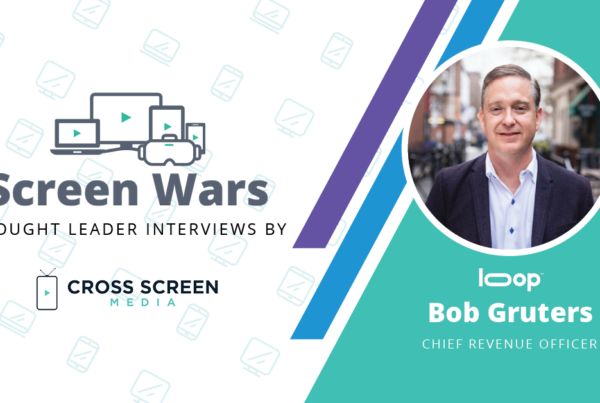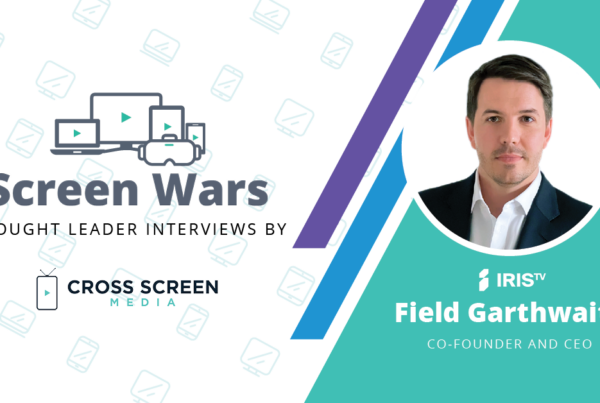Simulmedia CEO and Founder Dave Morgan joins Cross Screen Media CEO Michael Beach to share his expert opinions on video ad trends and opportunities, including the largely untapped potential of video games, in our latest Screen Wars Executive Interview. Read the full transcript below.
Michael Beach: Welcome to another edition of Screen Wars. Today it’s my pleasure to welcome Dave Morgan from Simulmedia. Dave is the founder and CEO of Simulmedia. Prior to starting the company in 2008, Dave founded Real Media and TACODA, two leaders in the digital space. Welcome Dave.
Dave Morgan: Thank you, Michael. I’m excited to be here.
MB: Dave is one of my favorite people in the convergent TV space. We were just joking around that he’s a true thought leader and we’re always following his writing and he’s probably been a guest contributor, whether he knew it or not, more times just about anybody else for State of the Screens and we appreciate it. Dave, you want to start us off and tell us what your first job was and how it set up your career?
DM: It’s some combination of in high school lifeguarding and I was a title abstractor, so I spent a lot of time in vaults at the little county courthouse in my hometown, digging out old books to track back title ownership, like a hundred or 150 years through depressions and sheriff sales. And then trying to re-plot those back. I’m from the mountains of Western Pennsylvania, so it’s coal country. So a lot of old coal and oil and gas leases. And I guess that taught me about speed, precision, but being able to take the big picture in. And having to work your way through a lot of stumbling blocks on the way.
MB: What do you think was your starting place for getting into the convergent TV space?
DM: It actually started 30 years ago when I was working in the newspaper industry and I was working on what we were calling New Media, so this is back in 1991. And the vision then was that the information super highway would plug into the back of the TV set and you’d order your pizza from the couch. That was literally what we were talking about. And I remember visiting the Bell Atlantic home of the future in Virginia, which was really set up for the lobbyists to experience a high Def TV screen and an air mouse and that vision.
So, when I went into the pure online world with Real Media and TACODA, it always was because that was what was available. The vision of that convergent TV was just too early. And so, after selling TACODA to Time Warner AOL, I spent a bunch of time around the Time Warner cable people, the Turner people, David Levy, who was running sales then. And it seemed to me that in 2008, we were at the time now when it was time to bring a digital approach, the digital approach to TV would work. I think it was still a little bit early, but that’s what took me, that’s what got me to here.
MB: Before we jump in any deeper, do you mind giving our community background on Simulmedia and where they sit in the convergent TV space?
DM: At Simulmedia we have a platform that automates the planning, buying, targeting, and activation and measurement of national TV advertising. And so a client like Dollar Shave Club or Experian or Electrolux was able to come in, take maybe a first party target or some more defined target than they typically would have used in TV. And then the data science and software determines where across all the top national cable networks, what are exactly the most precise spots where their audience will appear at the right volume, concentration, and likely duplication to maximize their plan. And then the system will literally put out thousands of insertion orders to each of those network companies, execute it, measure it running in real time, and have the closed loop comes back around. And test, learn, optimize their TV.
MB: One of the common themes that we keep hearing and a lot of our guests have talked about is siloed teams on the buy side. Is that something you’re still coming across? I’m sure you’ve seen a lot of progress there since the start, but where do we sit with silos today?
DM: I’m taking a big breath. Unfortunately, it has not improved nearly to the level it should. I think that the TV buying team stayed way too siloed for too long, and it created two problems. It created an enormous tension between digital buyers and TV buyers, and then we also did not have a transference of knowledge. And so one of the real big challenges that’s going on today, and I literally was just talking to the head of one of the TV network groups about this, is we’ve had an aging out of most of the expertise in TV buying, where really only one of the top five agency buying group has a long term veteran national TV buyer. And not only have we not seen the silos come together or converge as they need, but we’ve had a real loss of talent at the agency side around that, which obviously creates opportunities. 
Our business tends to go much more direct to client, direct to marketer. We tend to work with the marketers that want to put their hands more on how they do their TV, not unlike how they do their digital. And so that’s probably what’s going to happen. I think we won’t see the large agencies break the silos as well as they should, but I’m really excited for the small and medium-sized agencies. Like we were just referencing earlier, the Camelot agency down in Dallas, that’s probably as modern of an agency as I’ve ever seen.
MB: This might be connected, but I want to get your thoughts on Procter and Gamble news in the last week where they’re going to negotiate directly with media sellers. First, why did they do this? And then second, do you see this being a significant trend moving forward?
DM: Yes. I think why they did it is Marc Pritchard and Procter & Gamble had been looking for leverage against the ecosystem of the large buyers and the large networks that have wanted the upfronts conducted the same way they have for the last few decades. Where they were done mid-year, not in the calendar year, not consistent with corporate planning. The marketers have to buy upfront heavily and really expose all of their budgets. And there’s a fair amount of essentially wholesale buying, so you don’t exactly know what you’re going to get. I think Pritchard realized this was the year he was going to have to push it harder and went into the market much more directly with a lot of that negotiation.
I do think it’s going to have an impact on the industry. I think you’re going to see a lot of other marketers following that path. We’ve certainly gotten a lot of calls, just because I think the marketers realized that if in fact they do take more of a lead position as Procter and Gamble is, and move some of the classic buying to more of a supporting position, that they’re going to need technology platforms to manage that. I think it was significant, I think probably the piece that we haven’t seen yet that’s going to follow inevitably with that is also movement away from the sex/age/demographic buying, and much more towards a digital approach of persons two and older.
MB: Absolutely. A lot of people are saying that in the last six plus months, we’ve seen five to ten years of digital transformation. Is this something you agree with? And then secondly, do you think that as we come out of the pandemic here, that we’re going to shift back to the same trend line we were on before, or are we permanently on a different track?
DM: I think we are going to see some shifts that are going to be quite permanent and are really accelerating. So the chance of a rollback I think is much less. On the streaming side, we’re seeing the numbers now saying that, depending on what you count in it, that for TV device viewing of entertainment news programming that around 25% of it is now streamed. Comscore put some numbers out to make it a little higher, but that included YouTube and short form, which I don’t think we think of the same way in the TV market, but about 25 percent. And that’s up from 10% or 15% a couple of years ago, so that’s really significant. And I don’t think that changes. What’s interesting, and I think we really have to watch, is that the advertising load on streaming, the amount of all ad time on TV, it was only one or 2% before, and it’s only gone to three or 4% now, because the vast majority of streamed content is not carrying ads.
That’s probably not going to change soon. It doesn’t matter if there’s ad-supported Peacock or more ad-supported Hulu or ad-supported HBO Max, because most consumers when confronted with a choice are choosing to go ad free. Certainly we’re at a time when most of the streaming packages are discount priced. But there’s no question, this is a big change and a big shift. And probably the only thing that’s going to slow it down is the fact that we’re still in a place where about 35% of US households do not have fixed broadband at home. And we’ve got to solve that, because that’s also disproportionate with lower income and Black and Hispanic households.
MB: Absolutely. That’s an area that you’ve written about quite a bit. And I think people overlook is just that, that’s your ceiling for who can stream videos.
DM: There’s 110 million people that cannot get your message if you stream it. And for many companies, they are the consumers of the future that everybody needs to develop relationships with today.
MB: Another area I’m interested to hear your take on is the video game space. Overall, what type of advertising opportunity do you see there, and what are we looking at for the next five plus years there?
DM: There’s no question that we are now seeing a convergence between what’s happening in video games and what happens in movies and TV and entertainment programming. And we’re seeing a divergence of younger audiences away from the straight linear TV programming. And so we’ve been watching it for a while. You’ve seen a fair amount of growth in the ad business in the mobile gaming world, but that tends to be highly programmatic, it tends to be pretty low end, quite frankly, it’s pretty crappy ads for downloads and trying to sell other games.
There has been a desire among the large game publishers to find ways to introduce much more of a TV-like ad experience into the console world. With the recognition now that you’re looking at, gamers on average playing about an hour and a half of console Triple-A games a day, so for that group of audience that they’re doing more of that than they’re watching TV, and many times they’re not watching any TV. There’s been a real growth of a new economic driver in the gaming world, what’s called live services, or the currency is used to buy capabilities, cosmetics, jerseys, being re-spawned, things like that. But only about 10% of gamers actually spend money on that, 90% don’t. And so, with the growth of free-to-play games, you have games with fives and tens of millions of users on a daily basis where most of them are not being monetized. And most of them are willing to accept a permissioned ad. If we say, “Hey, will you watch an ad to get five of these coins or tokens or bucks or whatever you want to call them, to be able to use for those same capabilities?” And we think that’s going to be a really big opportunity. We have entered into an agreement with one of the largest game publishers in the world to help them build that out. We’re talking to most of the other major publishers, we’re running tests right now which have been going very successfully with a lot of top advertisers. And we think that in five years you will see by far more convergent TV inventory available for people under 35 on game consoles than you will see through either the cable set top box networks, or through networks on streamed connected TV. It is really big. 
MB: It’s incredible. And Matthew Ball writes a lot from the Fortnite angle.
DM: His stuff is amazing. I love Matthew Ball’s stuff.
MB: Incredible. Set aside an hour and read one of his essays. I start to see the Disney plus co-viewing, I think maybe it was one of the other MVPDs came out with it recently, there’s something there. You have these concerts going on in Fortnite and trailers getting released. And you’ve got co-viewing through streaming that I see converging at least for the younger demographic.
DM: No question. And I think it’ll expand up. Because of Matthew Ball’s writing, I went and read Snow Crash. I’d heard of it, but I had never read the book, it’s the science fiction novel that gave us the metaverse. And it’s amazing that there are so many things we have today that were anticipated in that book. But that’s playing out, and I think we have both what I’m describing, ad supporting games in ways that we find normal from older paradigms, to newer paradigms that we’re seeing where people are in the game, but not necessarily playing the game. They’re hanging out in the lobby and watching a movie, hanging out with friends, maybe consuming other kinds of programming. It’s really exciting. And I think that the agencies, the experts that figure out how to help brands and marketers deal with that, it’s going to be really exciting.
MB: A couple of marketplace questions here. First, what’s the biggest change that you’ve seen in the video ad marketplace and how has Simulmedia adapted to that?
DM: I think the biggest change has been is we’ve had a lot of consolidation and selling of companies and changing of sales forces. There’s just been this extraordinary amount of disruption in people. And the way we’ve adapted to it is, we’ve really accelerated our automation. We realized that the one way to deal with changing of teams and staffs and relationships and ownerships, was to build out the pipes so that we could plug more directly in. And so what we’ve done over the last two years was we went from a supply chain where we were probably 85% automated, to a supply chain where we’re 99% automated. Such that we can move ten to fifteen thousand different spot level insertion orders to 115 networks on a daily basis with just over four people in operations.
MB: That’s great. Looking ahead, what future development are you most excited about in the convergent TV space?
DM: I’m most excited about gaming. I’m most excited about how gaming comes together with everything else. I think it may become one of the real glues for this business. So I’m going to say that one a second time.
MB: In the current environment, if you could get your entire team to read one book, what would that book be and why?
DM: I would have everybody read Snow Crash. I think that it’s one of those novels that was ahead of its time. That’s certainly what a great science fiction novel should be. I think it will open a lot of people’s eyes to a world that seemed unattainable probably in 1993 when it came out, but today in 2020 is pretty extraordinary and has probably half of the story that we see today. I also think it’s just a fun read that twists your mind a little bit, and it’s probably a good time with everything going on out there to escape into a science fiction novel.
MB: That’s a great pick. Dave, it’s been an honor to have you on the show and we appreciate your time.
DM: You’re welcome. Thank you, Michael. I’m really honored to be part of it.
See the rest of the Screen Wars Thought Leader Interview series here!
Dave Morgan is the CEO and founder of Simulmedia. He previously founded and ran both TACODA, Inc., an online advertising company that pioneered behavioral online marketing and was acquired by AOL in 2007 for $275 million, and Real Media, Inc., one of the world’s first ad serving and online ad network companies and a predecessor to 24/7 Real Media (TFSM), which was later sold to WPP for $649 million. After the sale of TACODA, Dave served as Executive Vice President, Global Advertising Strategy, at AOL, a Time Warner Company (TWX).
A lawyer by training, Dave served as General Counsel and Director of New Media Ventures at the Pennsylvania Newspaper Association in the early 1990’s.
Dave is a Political Science graduate of The Pennsylvania State University and holds a J.D. from the Dickinson School of Law. Dave, his wife Lorea Canales, and their two daughters live in Manhattan.
Cross Screen Media is a marketing analytics and software company empowering marketers to plan, activate, and measure Connected TV and audience-driven Linear TV advertising at the local level. Our closed-loop solutions help brands, agencies, and networks succeed in the Convergent TV space. For more information, visit CrossScreenMedia.com.




